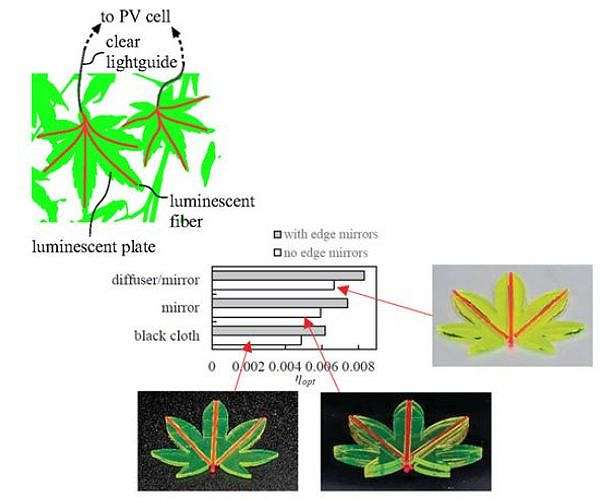Leaf-inspired solar concentrators can significantly improve efficiency
Luminescent solar concentrators (LSCs) have been a major focus of research since their inception in the 1970s, with the aim of improving solar energy capture by converting and concentrating sunlight on photovoltaic (PV) cells. Unlike traditional solar concentrators that rely on mirrors and lenses, LSCs can efficiently capture diffused light and are used in applications such as building-integrated solar photovoltaics, where their semi-transparent and colorful appearance adds aesthetic value.
However, scaling up LSCs to cover larger areas has faced challenges, such as the self-absorption of photoluminescent (PL) photons in the waveguide. Researchers from Ritsumeikan University in Japan have now introduced a new ‘leaf LSC’ design that promises to address these challenges by improving light collection and transmission to photovoltaic cells.
The newly proposed leaf LSC model addresses the scalability issue by using smaller, interconnected luminescent components that function similarly to leaves on a tree. According to a study published in the Journal of Photonics for Energy (JPE), the innovative setup consists of luminescent plates arranged around a central luminescent fiber, with the sides of the plates facing the fiber. This configuration allows incident photons to be converted by the plates into PL photons, which are then guided through the fiber and captured at the tip by a PV cell. To further increase efficiency, clear light guides connect multiple fibers to a single PV cell, increasing the incident area of the LSC and minimizing photon losses due to self-absorption and scattering.
This modular design offers several advantages. By reducing the lateral dimensions of individual modules, the researchers found that photon collection efficiency improved significantly. For example, reducing the side length of a square-blade LSC from 50 mm to 10 mm significantly improved photon collection efficiency. Additionally, the modular design allows for the easy replacement of damaged units and the integration of advanced luminescent materials as they become available.
To further improve system efficiency, the researchers incorporated techniques from traditional planar LSCs, such as edge mirrors and tandem structures, into the sheet LSC design. Their experiments showed that the optical efficiency of these sheet-like structures can be calculated analytically from the spectrum and intensity of incident light, using a single-spot excitation method.
“These findings demonstrate a creative approach that advances the concept of luminescent solar concentrators to effectively direct sunlight to adjacent photovoltaic devices. By combining scalable, bio-inspired designs with improvements in optical engineering, the authors have increased the efficiency of their devices in toward what’s needed for practical use,” said JPE Editor-in-Chief Sean Shaheen, professor of engineering and physics at the University of Colorado Boulder, and fellow of the Renewable and Sustainable Energy Institute.
Optimizing photon collection in LSCs could lead to more flexible and scalable solar energy solutions. These advances could revolutionize the application of solar concentrators, making them more efficient and adaptable for a variety of applications, from large-scale installations to building-integrated systems. As this technology continues to develop, it has the potential to significantly improve the performance of solar energy systems and contribute to more sustainable energy solutions.
Research report:Improved photon collection in leaf-inspired luminous solar concentrators


